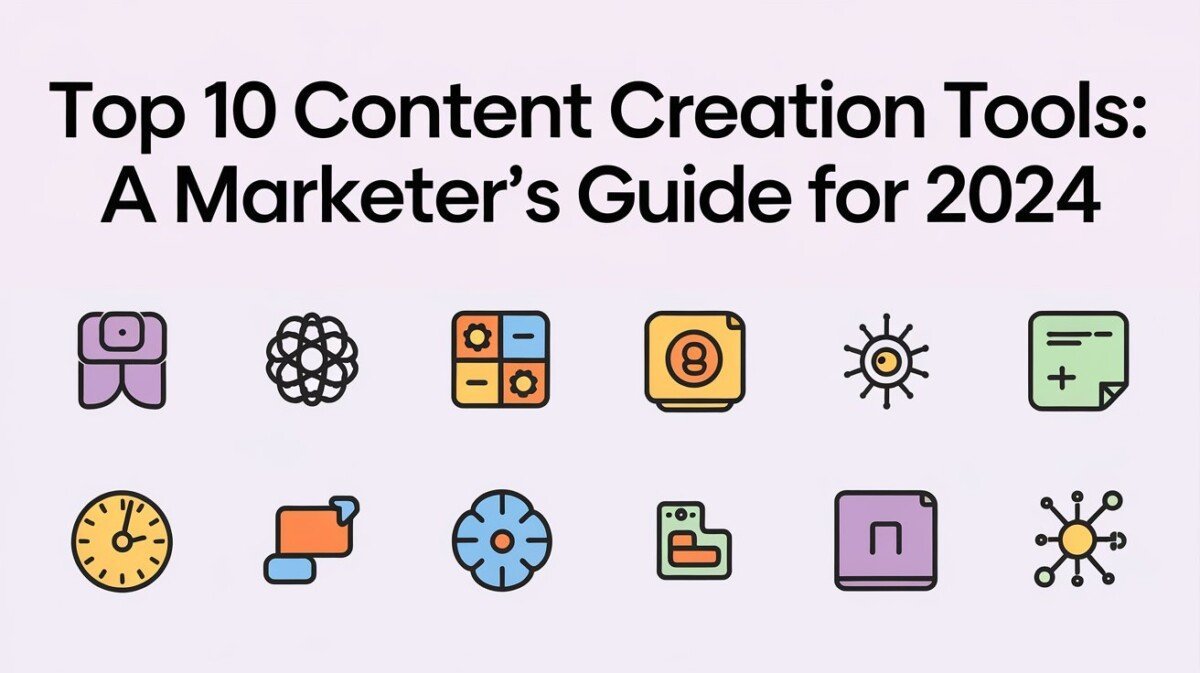Content creation tools help marketers work faster and come up with better ideas. Let’s look at the top 10 tools that can make your life easier in 2024, exploring their features and benefits. In addition to content creation tools, marketers can also benefit from using Instagram analytics tools to track the performance of their social media campaigns. These tools provide valuable insights into engagement, reach, and audience demographics, allowing marketers to make data-driven decisions and optimize their Instagram marketing strategy. By combining content creation and Instagram analytics tools, marketers can streamline their workflow and achieve better results in 2024.
Key Takeaways: Content Creation Tools
- AI Writing: Jasper AI, Copy.ai – Boost productivity and ideation
- Visual Content: Canva, Adobe Creative Suite – Create engaging graphics
- Video Creation: Promo.com, WaveVideo – Produce professional videos easily
- Social Media Management: Hootsuite, Buffer – Streamline posting and analytics
- SEO: SEMrush, Yoast SEO – Optimize content for search engines
- Email Marketing: Mailchimp, ConvertKit – Build and nurture audience relationships
- Content Management: WordPress, Contentful – Organize and publish content efficiently
- Analytics: Google Analytics, BuzzSumo – Track performance and trends
- All-in-One Platforms: HubSpot, NeuronWriter – Comprehensive marketing solutions
- Factors to Consider: Content type, Learning curve, Budget, Tool integration
1. AI-Powered Writing Assistants
AI writing tools are changing how content creators work. They can help you write faster and come up with fresh ideas. Two popular options are:
1. Jasper AI: This tool can write blog posts, social media content, and even books. It learns from what you tell it and tries to match your style. Jasper AI offers features like content rephrasing, tone adjustment, and plagiarism checking.
2. Copy.ai: Great for making ads, product descriptions, and email subject lines. It’s easy to use and can give you lots of ideas quickly. Copy.ai is good for short content and can help e-commerce businesses and digital marketers create catchy copy.

These AI tools can be a big help, but they’re not perfect. Always check and edit what they write to make sure it sounds like you and fits your brand. Use AI as a starting point or for inspiration, but add your own voice and expertise to the content.
2. Visual Content Creation Tools
Pictures and graphics can make your content more interesting and shareable. Here are two great tools for making visual content:
1. Canva: This is a favorite for many marketers. It’s easy to use and has lots of templates for social media posts, presentations, and more. Canva has many stock photos, illustrations, and fonts to help you create good-looking designs without being a pro.
2. Adobe Creative Suite: This is more advanced but great for making professional-looking graphics and videos. It includes tools like Photoshop, Illustrator, and Premiere Pro, giving you lots of control over your visual content.

Visual content can help your message stand out. Try using these tools to add some eye-catching graphics to your next project. Using the same style in all your visuals can help people recognize your brand more easily.
3. Video Creation and Editing Tools
Video is becoming more important in marketing, with platforms like TikTok and Instagram Reels getting popular. Here are two user-friendly video tools:
1. Promo.com: This tool makes it easy to create professional-looking videos, even if you’re not a video expert. It has many templates, stock footage, and music tracks to help you create engaging videos quickly.
2. WaveVideo: Another great option for making videos quickly. It has lots of stock footage you can use and makes it easy to edit and add effects to your videos. WaveVideo also lets you easily resize videos for different social media platforms.

Don’t be afraid of making videos. These tools can help you create great content without being a pro. Start with short, simple videos and try more complex ones as you get better.
4. Social Media Management Tools
Managing multiple social media accounts can be tough. These tools can help make your social media marketing easier:
1. Hootsuite: This lets you schedule posts, track mentions, and see how your content is doing across different platforms. Hootsuite’s dashboard allows you to manage multiple social media accounts from one place, saving time and helping you post consistently.
2. Buffer: Another great option for scheduling posts and analyzing your performance. Buffer is easy to use and gives you detailed information to help you understand what content your audience likes best.

These tools can save you time and help you post more regularly on social media. They also show you how well your posts are doing, helping you improve your social media strategy over time.
5. SEO and Content Optimization Tools
SEO is important for getting your content seen by the right audience. Here are two tools that can help improve your search engine visibility:
1. SEMrush: This tool can help you find good keywords, analyze your competitors, and see how your content is ranking. SEMrush also checks your content and backlinks to give you a full picture of your SEO performance.
2. Yoast SEO: If you use WordPress, this plugin can help you optimize your content for search engines. It gives you feedback on your content’s SEO and readability, helping you make improvements before publishing.

Using these tools can help more people find your content through search engines. Remember, good SEO is about creating valuable, relevant content for your audience, not just using keywords.
6. Email Marketing Platforms
Email is still a powerful way to reach people and build relationships with customers. Here are two popular email tools:
1. Mailchimp: This is great for beginners. It has easy-to-use templates and good analytics. Mailchimp lets you divide your audience into groups and test different versions of your emails to make them better.
2. ConvertKit: This is popular with bloggers and creators. It’s good for setting up automated email sequences and helps you send personalized content to different groups of subscribers.

Email marketing can help you stay in touch with your audience and turn readers into customers. Focus on providing value in your emails and always respect your subscribers’ choices and privacy.
7. Content Publishing and Management Systems
These tools help you organize and publish your content efficiently:
1. WordPress: This is the most popular platform for building websites and blogs. It offers many themes and plugins to customize your site and add new features.
2. Contentful: This is a more advanced system that’s good for managing content across different platforms. It’s useful for bigger organizations that need to share content on multiple channels and devices.

Having a good system for managing your content can make your work much easier and help you keep things consistent across all your online platforms.
8. Analytics and Performance Tracking Tools
It’s important to know how your content is doing so you can make it better. These tools can help:
1. Google Analytics: This free tool gives you lots of information about who’s visiting your website and what they’re doing there. It shows you where your visitors come from and how many of them take actions you want, like buying something.
2. BuzzSumo: This can show you what content is popular in your industry and who’s sharing it. It’s great for researching content ideas and finding influential people in your field.

Using these tools can help you understand what’s working and what’s not in your content strategy. Regularly check your analytics to spot trends and adjust your approach.
9. All-in-One Marketing Platforms
Some tools try to do a bit of everything, offering comprehensive solutions for marketers. Here are two popular options:
1. HubSpot: This platform includes tools for marketing, sales, and customer service. It offers features like CRM, email marketing, social media management, and content creation tools all in one place.
2. NeuronWriter: This tool combines SEO analysis, content optimization, and AI writing assistance. It’s designed to help you create SEO-friendly content from start to finish.
These all-in-one platforms can be expensive, but they might save you money if you’re using lots of different tools. They can also help make sure all your marketing efforts work well together.
10. Choosing the Right Content Creation Tools
When picking tools, think about:
- What kind of content you make most often
- How much time you have to learn new tools
- Your budget
- Whether the tools work well together
- The size of your team and how you need to work together
- Your specific marketing goals and how you measure success

It’s okay to start small. Try free versions of tools before you buy them. And remember, the best tool is the one you’ll actually use! Don’t worry about having every tool out there; focus on the ones that really help you work better and create better content.
Conclusion
Content creation tools can make your job as a marketer much easier. They can help you come up with ideas, create content faster, and see how well your content is doing. But remember, tools are just helpers. The most important thing is still your creativity, understanding of your audience, and ability to create valuable, interesting content.
Try out different tools and see what works best for you and your team. Don’t be afraid to try new technologies and ways of doing things. And most importantly, keep creating great content that your audience will love!

As you explore these tools, remember that content creation is always changing. Stay curious, keep learning, and be ready to try new tools as they come out. Happy creating!



